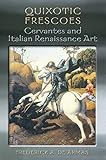Quixotic Frescoes : Cervantes and Italian Renaissance Art / Frederick A. de Armas.
Material type: TextPublisher: Toronto : University of Toronto Press, [2006]Copyright date: ©2006Description: 1 online resource (344 p.)Content type:
TextPublisher: Toronto : University of Toronto Press, [2006]Copyright date: ©2006Description: 1 online resource (344 p.)Content type: - 9780802090744
- 9781442678965
- 863/.3 22
- online - DeGruyter
| Item type | Current library | Call number | URL | Status | Notes | Barcode | |
|---|---|---|---|---|---|---|---|
 eBook
eBook
|
Biblioteca "Angelicum" Pont. Univ. S.Tommaso d'Aquino Nuvola online | online - DeGruyter (Browse shelf(Opens below)) | Online access | Not for loan (Accesso limitato) | Accesso per gli utenti autorizzati / Access for authorized users | (dgr)9781442678965 |
Browsing Biblioteca "Angelicum" Pont. Univ. S.Tommaso d'Aquino shelves, Shelving location: Nuvola online Close shelf browser (Hides shelf browser)

|

|

|

|

|

|

|
||
| online - DeGruyter Quaqtaq : Modernity and Identity in an Inuit Community / | online - DeGruyter Queer Judgments : Homosexuality, Expression, and the Courts in Canada / | online - DeGruyter Questions of Tradition / | online - DeGruyter Quixotic Frescoes : Cervantes and Italian Renaissance Art / | online - DeGruyter Racial Profiling in Canada : Challenging the Myth of 'a Few Bad Apples' / | online - DeGruyter Ragas of Longing : The Poetry of Michael Ondaatje / | online - DeGruyter Rapt in Plaid : Canadian Literature and Scottish Tradition / |
restricted access online access with authorization star
http://purl.org/coar/access_right/c_16ec
As a young man, Miguel de Cervantes left his home in Spain and travelled extensively through Italy, experiencing all that the Italian Renaissance had to offer. In his later writings, Cervantes sought to recapture his experience through literature, and literary critics have often pointed to Italian texts as models for Cervantes? writing. The art of the period, however, has seldom been examined in this context.Focusing on Don Quixote, Frederick A. de Armas unearths links between Cervantes? text and frescoes, paintings, and sculptures by Italian artists such as Cambiaso, Michelangelo, Raphael, and Titian. His study seeks to re-engage the critics of today by formulating the link between Cervantes and the Renaissance through an interdisciplinary dialogue that establishes a new set of models and predecessors. This dialogue is used to explore a variety of issues in Cervantes including the absence of a single guiding pictorial program, the doubling of archaeological reconstruction, and the use of ekphrasis as allusion, interpolation, and an integral component of the action. Quixotic Frescoes delves into the politics of imitation, self-censorship, religious ideology expressed through the pictorial, as well as the gendering of art as reflected in Cervantes? work. This detailed and exhaustive study is an invaluable contribution to both Hispanic and Renaissance studies.
Mode of access: Internet via World Wide Web.
In English.
Description based on online resource; title from PDF title page (publisher's Web site, viewed 01. Nov 2023)


